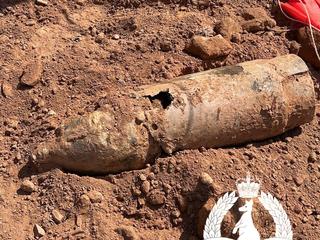15/07/2024 Australia, Territorio del Nord, (Northern Territory) Darwin
“If you ever come across anything suspicious like this item, please do not pick it up, contact your local law and/or enforcement agency for assistance”
Warrant Officer Class Two (WO2) Kyle Johnson arrived at work on June 26 expecting a routine day. After a phone call from Northern Territory Police later that afternoon, however, his team members were on their way to Stokes Hill waterfront precinct in Darwin to dispose of a World War 2-era Japanese bomb. It all started with contractors at the upcoming Larrakai Cultural Centre in Darwin discovering an odd find rolling around in their excavator bucket. The North Queensland Joint Explosive Ordnance Support (JEOS) team was then contacted to assess the situation. WO2 Johnson said the contractors did the right thing calling the police, who called the unit and provided a photo. “We originally were told it was a possible grenade, which is something that we see quite regularly,” WO2 Johnson said. “But after hearing it was about 45 centimetres long, this raised our alarm. We lighted up the vehicle and proceeded down to the waterfront to get our eyes on it.” The unexploded ordnance (UXO) was assessed as a 60kg Type 98 No.7 Mk 6 incendiary bomb Model 1. Despite its age, the risk of it malfunctioning was high and needed to be safely managed by the JEOS team. “Older unexploded ordnance are still very dangerous. You never know. Having it tossed around in an excavator bucket could have been the last straw for that fuse, even after 80 years,” WO2 Johnson said. “Following best practice, a cordon was established allowing only essential personnel. We then conducted the procedures necessary to make the area 100 per cent safe.” WO2 Johnson and Corporal Russell Forrest, with support provided by 1 Combat Service Support Battalion, 1st Brigade, transferred the bomb to an excavated 1.8-metre-deep hole for destruction by explosives. “It’s not as dramatic as in the movies, but the explosion lifted two tons of covering sandbags a good 30 metres in the air. I wouldn’t want to be standing on it, put it that way,” WO2 Johnson said. The ADF JEOS team’s personnel deal with about 420 UXO callouts in Australia each year.
If you find anything that appears to be an explosive device, do not touch it, leave it where it is and call the police. We will contact the appropriate agencies to properly dispose of the item.
Dear editors, Biography of a bomb is aimed at highlighting the danger caused by unexploded bombs. Moreover, the most important aspect is that we work completely non profit, what drives us is raising awerness about this topic. We make use of your pictures and articles, but we need them to put a context in how findings are done. We trust in your understanding. We will (and we always do) cite the source and the author. We thank you for your comprehension.





